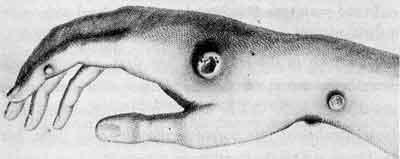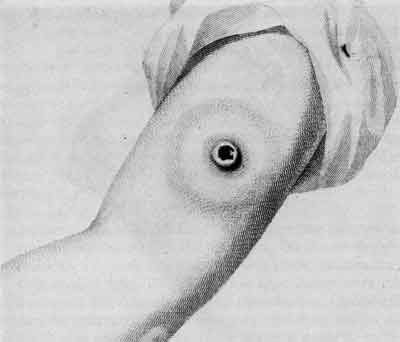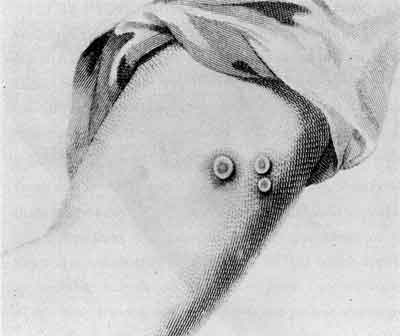Testing for Resistance to Smallpox in
People Who Have Been Inoculated with Cow-pox
After the many fruitless attempts to give the smallpox to those who had
the cow-pox, it did not appear necessary, nor was it convenient to me,
to inoculate the whole of those who had been the subjects of these late
trials; yet I thought it right to see the effects of variolous matter on
some of them, particularly William Summers, the first of these patients
who had been infected with matter taken from the cow. He was, therefore,
inoculated with variolous matter from a fresh pustule; but, as in the preceding
cases, the system did not feel the effects of it in the smallest degree.
I had an opportunity also of having this boy and William Pead inoculated
by my nephew, Mr. Henry Jenner, whose report to me is as follows:
"I have inoculated Pead and Barge, two of the boys whom you
lately infected with the cow-pox. On the second day the incisions
were inflamed and there was a pale inflammatory stain around them.
On the third day these appearances were still increasing and their arms
itched considerably. On the fourth day the inflammation was evidently
sudsiding, and on the sixth day it was scarcely perceptible. No symptom
of indisposition followed.
"To convince myself that the variolous matter made use of was in
a perfect state I at the same time inoculated a patient with some of it
who never had gone through the cow-pox, and it produced the smallpox in
the usual regular manner."
These experiments afforded me much satisfaction; they proved that the matter,
in passing from one human subject to another, through five gradations,
lost none of its original properties, J. Barge being the fifth who received
the infection successively from William Summers, the boy to whom it was
communicated from the cow.
General Observations
I shall now conclude this inquiry with some general observations on the
subject, and on some others which are interwoven with it.
Although I presume it may be unnecessary to produce further testimony
in support of my assertion "that the cow-pox protects the human constitution
from the infection of the smallpox," yet it affords me considerable satisfaction
to say that Lord Somerville, the President of the Board of Agriculture,
to whom this paper was shewn by Sir Joseph Banks, has found upon inquiry
that the statements were confirmed by the concurring testimony of Mr. Dolland,
a surgeon, who resides in a dairy country remote from this, in which these
observations were made. With respect to the opinion adduced "that
the source of the infection is a peculiar morbid matter arising in the
horse," although I have not been able to prove it from actual experiments
conducted immediately under my own eye, yet the evidence I have adduced
appears sufficient to establish it.
They who are not in the habit of conducting experiments may not be aware
of the coincidence of circumstances necessary for their being managed so
as to prove perfectly decisive; nor how often men engaged in professional
pursuits are liable to interruptions which disappoint them almost at the
instant of their being accomplished: however, I feel no room for
hesitation respecting the common origin of the disease, being well convinced
that it never appears among the cows (except it can be traced to a cow
introduced among the general herd which has been previously infected, or
to an infected servant) unless they have been milked by some one who, at
the same time, has the care of a horse affected with diseased heels....
-
May it not ... be reasonably conjectured that the source of the smallpox
is morbid matter of a peculiar kind, generated by a disease in the horse,
and that accidental circumstances may have again and again arisen, still
working new changes upon it until it has acquired the contagious and malignant
form under which we now commonly see it making its devastations amongst
us?
-
And, from a consideration of the change which the infectious matter undergoes
from producing a disease on the cow, may we not conceive that many contagious
diseases, now prevalent among us, may owe their present appearance not
to a simple, but to a compound, origin?
-
For example, is it difficult to imagine that the measles, the scarlet fever,
and the ulcerous sore throat with a spotted skin have all sprung from the
same source, assuming some variety in their forms according to the nature
of their new combinations?
The same question will apply respecting the origin of many other contagious
diseases which bear a strong analogy to each other.
Natural Varieties of Smallpox
There are certainly more forms than one, without considering the common
variation between the confluent and distinct, in which the smallpox appears
in what is called the natural way. About seven years ago a species
of smallpox spread through many of the towns and villages of this part
of Gloucestershire: it was of so mild a nature that a fatal instance
was scarcely ever heard of, and consequently so little dreaded by the lower
orders of the community that they scrupled not to hold the same intercourse
with each other as if no infectious disease had been present among them.
I never saw nor heard of an instance of its being confluent. The
most accurate manner, perhaps, in which I can convey an idea of it is by
saying that had fifty individuals been taken promiscuously and infected
by exposure to this contagion, they would have had as mild and light a
disease as if they had been inoculated with variolous matter in the usual
way. The harmless manner in which it shewed itself could not arise
from any peculiarity either in the season or the weather, for I watched
its progress upwards of a year without perceiving any variation in its
general appearance. I consider it then as a variety of the
smallpox.
Proper and Improper Inoculation Methods
...A medical gentleman (now no more), who for many years inoculated in
this neighbourhood, frequently preserved the variolous matter intended
for his use on a piece of lint or cotton, which, in its fluid state, was
put into a vial, corked, and conveyed into a warm pocket; a situation certainly
favourable for speedily producing putrefaction in it. In this state
(not unfrequently after it had been taken several days from the pustules)
it was inserted into the arms of his patients, and brought on inflammation
of the incised parts, swellings of the axillary glands, fever, and sometimes
eruptions.
But what was this disease?
Certainly not the smallpox; for the matter having from putrefaction
lost or suffered a derangement in its specific properties, was no longer
capable of producing that malady, those who had been inoculated in this
manner being as much subject to the contagion of the smallpox as if they
had never been under the influence of this artificial disease; and many,
unfortunately, fell victims to it, who thought themselves in perfect security....
Whether it be yet ascertained by experiment that the quantity of variolous
matter inserted into the skin makes any difference with respect to the
subsequent mildness or violence of the disease, I know not; but I have
the strongest reason for supposing that if either the punctures or incisions
be made so deep as to go through it and wound the adipose membrane, that
the risk of bringing on a violent disease is greatly increased.
I have known an inoculator whose practice was "to cut deep
enough (to use his own expression) to see a bit of fat," and there to lodge
the matter. The great number of bad cases, independent of inflammations
and abscesses on the arms, and the fatality which attended this practice,
was almost inconceivable; and I cannot account for it on any other principle
than that of the matter being placed in this situation instead of the skin.
It was the practice of another, whom I well remember, to pinch up a
small portion of the skin on the arms of his patients and to pass through
it a needle, with a thread attached to it previously dipped in variolous
matter. The thread was lodged in the perforated part, and consequently
left in contact with the cellular membrane. This practice was attended
with the same ill success as the former....
A very respectable friend of mine, Dr. Hardwicke, of Sodbury in this county,
inoculated great numbers of patients ... and with such success that a fatal
instance [rarely] occurred.... It was the doctor's practice to make
as slight an incision as possible upon the skin, and there to lodge a thread
saturated with the variolous matter. When his patients became indisposed,
agreeably to the custom then prevailing, they were directed to go to bed
and were kept moderately warm.
Is it not probable then that the success of the modern practice may
depend more upon the method of invariably depositing the virus in or upon
the skin, than on the subsequent treatment of the disease?...
I cannot account for the uninterrupted success, or nearly so, of one
practitioner, and the wretched state of the patients under the care of
another, where, in both instances, the general treatment did not differ
essentially, without conceiving it to arise from the different modes of
inserting the matter for the purpose of producing the disease....
Advantages of Cow-pox over Smallpox Inoculation
Unlike Smallpox, Cow-pox is Not Fatal
Should it be asked whether this investigation is a matter of mere curiosity,
or whether it tends to any beneficial purpose, I should answer that, notwithstanding
the happy effects of inoculation, with all the improvements which the practice
has received since its first introduction into this country, it not very
unfrequently produces deformity of the skin, and sometimes, under the best
management, proves fatal.
These circumstances must naturally create in every instance some degree
of painful solicitude for its consequences. But as I have never
known fatal effects arise from the cow-pox, even when impressed in
the most unfavourable manner, producing extensive inflammations and suppurations
on the hands; and as it clearly appears that this disease leaves the
constitution in a state of perfect security from the infection of the smallpox,
may we not infer that a mode of inoculation may be introduced preferable
to that at present adopted, especially among those families which,
from previous circumstances, we may judge to be predisposed to have the
disease unfavourably?
It is an excess in the number of pustules which we chiefly dread in
the smallpox; but in the cow-pox no pustules appear, nor does it seem possible
for the contagious matter to produce the disease from effluvia, or by any
other means than contact, and that probably not simply between the virus
and the cuticle; so that a single individual in a family might at any time
receive it without the risk of infecting the rest or of spreading a distemper
that fills a country with terror.
Cow-pox Is Not Transmitted by Air
Several instances have come under my observation which justify the assertion
that the disease cannot be propagated by effluvia. The first boy
whom I inoculated with the matter of cow-pox slept in a bed, while the
experiment was going forward, with two children who never had gone through
either that disease or the smallpox, without infecting either of them.
A young woman who had the cow-pox to a great extent, several sores which
maturated having appeared on the hands and wrists, slept in the same bed
with a fellow-dairymaid who never had been infected with either the cow-pox
or the smallpox, but no indisposition followed.
Another instance has occurred of a young woman on whose hands were several
large suppurations from the cow-pox, who was at the same time a daily nurse
to an infant, but the complaint was not communicated to the child.
Cow-pox Produces Few Complications to Existing Conditions
In some other points of view the inoculation of this disease appears preferable
to the variolous inoculation.
In constitutions predisposed to scrophula [swellings
of the neck often associated with tuberculosis], how frequently
we see the inoculated smallpox rouse into activity that distressful malady!
This circumstance does not seem to depend on the manner in which the distemper
has shewn itself, for it has as frequently happened among those who have
had it mildly as when it has appeared in the contrary way.
There are many who, from some peculiarity in the habit, resist the common
effects of variolous matter inserted into the skin, and who are in consequence
haunted through life with the distressing idea of being insecure from subsequent
infection. A ready mode of dissipating anxiety originating from such
a cause must now appear obvious. And, as we have seen that the constitution
may at any time be made to feel the febrile attack of cow-pox, might it
not, in many chronic diseases, be introduced into the system, with the
probability of affording relief, upon well-known physiological principles?...
____________
Thus far have I proceeded in an inquiry founded, as it must appear,
on the basis of experiment; in which, however, conjecture has been occasionally
admitted in order to present to persons well situated for such discussions,
objects for a more minute investigation. In the mean time I shall
myself continue to prosecute this inquiry, encouraged by the hope of its
becoming essentially beneficial to mankind. |




